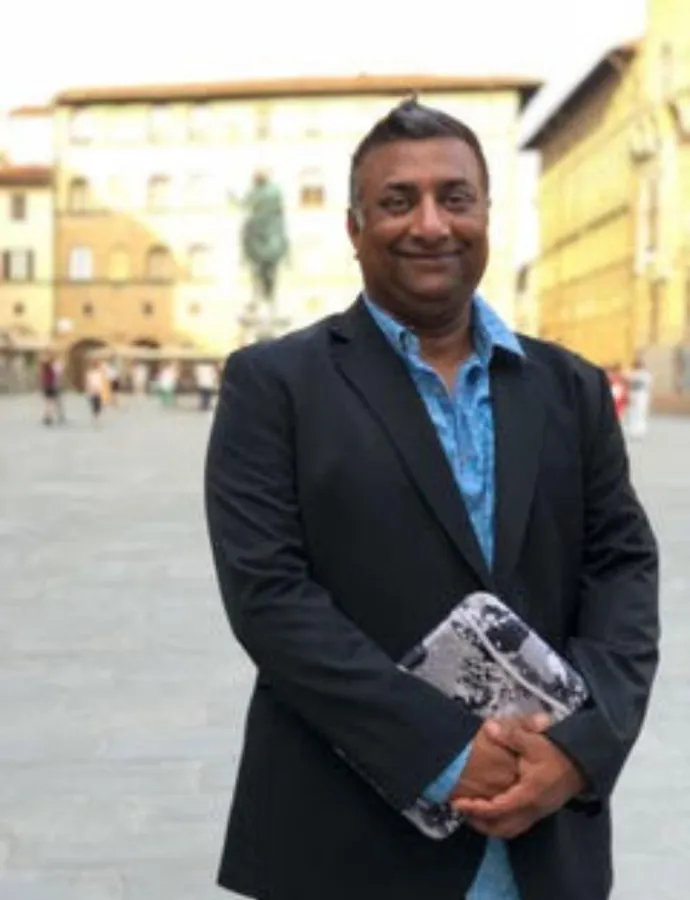“My goal in A&P is getting students to understand that I’m giving you the material and the resources, but it’s your job to actually comprehend, understand, and be able to articulate the content. You’re not studying for the tests, you’re studying to learn the concepts. The test is just an evaluation measure. The goal is figuring out how to get students to think independently, troubleshoot, and be able to get outside of their comfort zone. Connecting those dots is what I’m trying to accomplish.”
Kaushik Dutta has been teaching courses in Human Anatomy and Physiology for over 20 years. Read on to learn why he is working to turn students into independent thinkers again, and discover his tried and true method for success.

Kaushik Dutta at the at Piazza Della Signoria during his travel course
Shifting educational landscapes
Professor Kaushik Dutta is no stranger to taking on new challenges. Prior to accepting a teaching position at the University of New England (UNE) in Biddeford, Maine, Kaushik spent time exploring a variety of professional avenues and working across different research projects and laboratories. After years of spending most of his time with just the laboratory rig as company, Kaushik set off on a new venture in teaching, excited by the prospect of sharing thoughts, ideas, and conversations with students that were eager to learn.
This decision led him to become a teaching professor at the University of New England, where he teaches courses in Human Anatomy and Physiology for undergraduate students in the Health Profession programs. Since starting at UNE, Kaushik has also built a neuroscience lab and established a travel course that involves taking students to Italy to study the history and coevolution of human anatomy and art.
“I like the idea that it’s a very free-flowing medium” Kaushik notes when reflecting on his decision to become an educator. It’s having conversations with people that are wanting to learn something similar to what I am talking about, and getting them jazzed up about it. That’s what I really like. You’re not necessarily giving them every answer, but you are encouraging them to be curious and interested, to see the possibilities and discover their own abilities.”
Of course, teaching has brought on a whole new set of challenges. The aftermath of COVID created lasting structural changes to universities and resulted in an explosion of new, online teaching resources. Educators have struggled to navigate these hurdles without feeling overwhelmed.
“The landscape right now is quite volatile…There's a lot of shifts going on. Fundamentally, my role is to focus on what we already know works really well and then connect those dots to the students the best way we can and in the most linear way.”
Variability across the student mindset
Universities and educators aren’t the only ones facing the effects of this changing landscape, the impact on students has not gone unnoticed. More and more, educators are seeing a lack of resourcefulness and engagement in students coming into university.
“Many years ago, I had a lot less resources in my class, primarily because technology hadn’t evolved at the time. We didn’t have many tools, or the tools that did exist were rudimentary…But the students were quite resourceful and they were able to troubleshoot” Kaushik notes. Now, even with a variety of new technologies and resources available, students are struggling to find the motivation to actually learn concepts.
“There is a lack of ability to adapt and persevere on their own. I think that comes from what happened during COVID. Accountability went down quite a bit. There’s a mindset of oh well, if I don’t do this on time I can just write to the professor and they will make it right for me. That assumption still exists and it’s part of the problem that we are seeing - the lack of engagement, lack of trying, and lack of making it their own.”
While this mindset can vary from one individual to another, the variability across students when it comes to motivation, ability, and preparation adds a layer of difficulty. Especially for Kaushik, who teaches courses upwards of 120 to 140 students.
“You have to account for all of that, and that’s the secondary challenge. You are taking in a lot of students to meet student count but it comes with this inherent challenge of variability.”
This is the primary hurdle for Kaushik and for many educators today - changing the mindset of students and encouraging them to become independent thinkers once again. It’s why Kaushik has taken on a new philosophy that he shares with students at the start of each semester.
“I start off by saying to students that I’m here to learn what will help you, but you’re here to learn the content. Getting them to learn and get back to a better mindset is the goal.”
So how is Kaushik working to accomplish this goal?
The importance of simple and measurable interventions
For Kaushik, it comes down to taking it one step at a time. Focusing on what he knows already works, and then building on that in a way that makes sense for his courses and students.
“In many places, it seems like a lot of what’s going on is just throwing everything at the wall and seeing what sticks. With a lot of the people I talk to, it’s either they are so overwhelmed that they can’t move forward or they are doing everything under the sun and not knowing what the outcome is supposed to be.”
Small interventions with measurable goals have been the key to Kaushik’s success when it comes to implementing new technologies.
“I have tried to keep my teaching very simple and measurable. I implement something new that’s small, and then I evaluate it. I see its merit and decide whether to move forward with it or not. Every year is a staging for new things, some stick and some don’t. But underlying all of that, there's a framework that stays the same. For A&P we have the lab curriculum and lecture curriculum, those two are quite integrated and we just try to improve upon that every year.”

While it’s easy to be overwhelmed with the flood of new resources out there, Kaushik has relied upon a consistent framework and followed this simple process when looking at how to improve the experience for students. Staying true to this process, he has found success in his lab thus far.
“We are trying to make it the best possible scenario for students to succeed. My class actually has benefited from all this technology over the years and from the very tried and true methods that have been put in place. But I know there’s a big chunk of students that don’t make it nationally. In this case, I'm lucky to say that with a really hard push and with the technology that's in place, I’m getting good results with students making it.”
Use of technology to improve student engagement
A long time user of ADInstruments solutions, Kaushik was among the first in North America to test out and adopt the Lt online learning platform when it was released. He created all of his own original anatomy content at the time, and was able to build out his own lessons with images and media that he collected. Over the years, lab content was revised, edited, and updated. New add-ons were created by the faculty team teaching A&P for the Health Profession students.
Nowadays, Kaushik utilizes his own content and blends it together with the Anatomy Content Collection and Human Physiology Content Collection.
“I already made a lot of custom labs, so those are still serving us well. The Lt Anatomy content has been blended in with the custom labs, while the Lt Human Physiology labs are directly incorporated into the curriculum and customized to the major themes.”
Kaushik appreciates how the platform allows him to manage and standardize content delivery across multiple labs.
“The Lt platform serves us well to manage curricular standardization across labs, including those taught at our international campus in Tangier, Morocco. As an instance administrator, I can easily manage the platform to streamline the process of onboarding faculty and offering uniform content through the template course.”
Incorporating the Lt learning platform and Lt Sensors hardware into his lab has allowed Kaushik to build out a bridge of connection for his students. Students enjoy the ability to collect and analyze their own physiological data with the sensors, and the platform helps Kaushik to deliver the content and involve students in a systematic way.
He enjoys that it gives students the ability to remain connected to the concepts they are learning, even when they are not actively in the lab.

Kaushik's students performing a lab in Lt
“Based on the feedback from students, they use Lt a lot more. Because of the extended tasks that they have to do afterwards, it keeps them more engaged with the content even when they aren’t in the lab.”
Continuing to bridge the gap
Of course, technology does not solve all of the challenges when it comes to improving student mindset. The gaps still exist in comprehension and engagement, and Kaushik is still testing new strategies to tackle this problem. He is working on additional ways to utilize Lt and Lt Sensors to continue bridging that gap.
“I’ve started working on something I call “Lab Lecture Connections” as a bridge curriculum. That’s where I’m using a lot of the Lt content right now, especially the Anatomy Collection. It’s a post-lab and post-lecture unit to reinforce those concepts for students.”
He hopes these bridge courses will continue helping students when they leave the lab, keeping them connected to the content they are actively learning.
For other educators out there who are struggling with similar issues and working to integrate new technologies to improve student engagement, Kaushik offers this advice.
“Pick something small enough to implement well and evaluate it. Keep it simple and measurable, you’ve got to work out the workflow!”
ADInstruments is proud to support and work with educators like Kaushik Dutta, who aspire to genuinely serve their students and ultimately best prepare them for the future.
Despite leaving the bench sciences behind, Kaushik has maintained a strong interest in research. His focus now is on education technology and the effective use of it in the classroom.
We’d like to thank Kaushik for taking the time to speak with us and wish him the best of luck with his continued research and teaching!

Kaushik Dutta, M.S
Kaushik Dutta
Teaching Professor
School of Biological Sciences
University of New England
In 2017, Kaushik was the recipient of the Digital Learning Innovation Award (a national award funded by the Gates Foundation) by Online Learning Consortium. This award was presented to him in recognition of his outstanding work in blended curriculum design, and the use of digital courseware to improve student learning outcomes.
